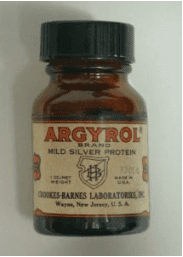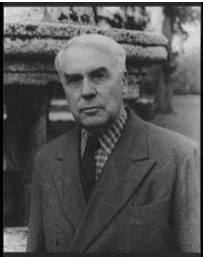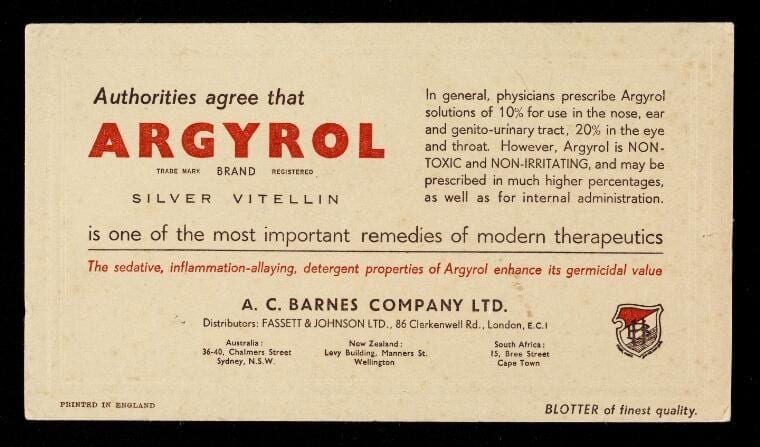Sylvia Karasu
New York, New York, United States
 |
| Argyrol, the compound developed by Dr. Albert C. Barnes and Dr. Hermann Hille to treat ophthalmia neonatorum, a conjunctivitis that led to blindness in newborns then caused by gram-negative gonococcus bacteria. Infection was contracted from mothers during vaginal delivery. Credit: Argyrol bottle, c. 1902-1907, Barnes & Hille. Objects Collection. Barnes Foundation Archive, Philadelphia, PA. Image Copyright 2020 The Barnes Foundation, used with permission. |
Albert C. Barnes is known as the man who accumulated an incomparable art collection for a foundation that bears his name. Few, though, may know how he earned a place in the history of medicine, specifically through his development of Argyrol, the unique compound that was the source of his fortune, or how he brought his scientific orientation to the study of art.
His life reads like a peculiar amalgamation of the American dream and a Greek tragedy. Born in 1872 in the slums of Philadelphia, he was the third of four sons (two of whom would die in early childhood)1 to a “marvelous mother, with a keen, penetrating intelligence” and an ineffectual father “lacking in character.”2 His father, originally a butcher, had been severely wounded while fighting for the Union during the Civil War. Losing his arm to gangrene, he was never able to support his family adequately.3 Moving frequently, the family became downwardly mobile to an area strewn with garbage, pigs roaming streets before their slaughter, rats, and gangs.4 Barnes, who became an imposing figure at almost six feet,5 defended himself against neighborhood bullies by learning to box.6 His athletic prowess would later help him support himself through school. His impoverished childhood, including experiencing hunger7 and wearing frayed clothing,8 would leave its indelible mark, as that kind of childhood invariably does. He would never lose his determination to defend himself from any perceived attack, often to his own detriment. With his self-defeating “volcanic anger,” he kept “grievances brightly intact for decades”9 and was “irrepressibly provocative.”10
Barnes attended the prestigious Central High School of Philadelphia, known to accept boys of “superior intelligence.”11 There he would meet the future artist William Glackens, a major influence on him throughout his life.12 Encouraged by his mother to pursue medicine after he received an advanced degree from Central High13 he matriculated at the University of Pennsylvania School of Medicine and graduated by age twenty,14 with particular interests in chemistry and pharmacology. After an internship at a psychiatric hospital, he said, “The experience led me to believe I was not cut out for medicine,”15 though he maintained a curiosity about psychology throughout his life.16 He traveled to Germany for further studies in pharmacology, but ultimately returned to Philadelphia where he accepted a job with the pharmaceutical firm H.K. Mulford & Company.17
At the request of the company, Barnes returned to Germany to recruit a researcher. It was there in Heidelberg that Barnes met Hermann Hille, “a brilliant research chemist”18 who had studied with Roentgen and had his PhD.19 Barnes convinced Hille to relocate to Philadelphia.20 It was around this time that he met his future wife Laura, with whom he would remain married until his death fifty years later. He and Laura never had children.21
 |
| Portrait of Dr. Albert C. Barnes, Barnes Foundation, Merion, PA., 1940, by photographer Carl Van Vechten. Credit: Library of Congress, Prints & Photographs Division, Carl Van Vechten Collection. |
Hille and Barnes ultimately left Mulford and in 1902 they partnered to form the Barnes & Hille Company. Shortly after, they developed the compound Argyrol that would make Barnes a millionaire many times over. Though Barnes would later minimize Hille’s contribution by referring to him as an unnamed “technician,”22,23 most believe that Hille provided the scientific expertise “crucial to the chemical development” of Argyrol.24 Their company also developed the much less successful Ovoferrin, an iron compound used to treat anemia.25
Argyrol, derived from a wheat protein and classified as a vitellin, “a protein occurring naturally in the yolk of an egg” to which silver salts were added,26 was an important addition to the physician’s armamentarium. At the turn of the last century, well before the development of antibiotics, there were few medications for infections and most (e.g., mercury, silver salts, boric acid, chlorine, phenol) were “far too toxic.”27 Dr. Carl Credé (1819-1892), a German professor of obstetrics, was the first in the early 1880s to use silver nitrate drops prophylactically for ophthalmia neonatorum,28,29,30 conjunctivitis seen within the first weeks of life31 then almost always caused by the transmission of the gram-negative gonococcus from the mother, who went often undiagnosed, to her infant during vaginal delivery.32 Without treatment, 30 to 50% of infants exposed during delivery developed corneal ulceration, perforation of the globe, and permanent visual impairment, including blindness;33 gonorrhea was then responsible for a quarter of all cases of lost eyesight throughout the world.34 Credé’s silver nitrate prophylaxis was considered a “significant preventive medicine triumph” when there was no effective treatment for gonorrhea.35
The problem with silver nitrate ophthalmic drops, though, is that they were irritating to the eye and caused a transient chemical conjunctivitis in up to 90% of infants.36 Argyrol, named for the Greek word for silver, had unique properties. It was 30% silver, twice the amount of silver produced before, exerted bactericidal properties in the deep mucous membranes of the eye where the gonococci reside, and unlike silver nitrate, it had no caustic or irritating properties.37 Barnes and Hille reported their results in 1902 to the American Therapeutic Society. Though they detailed their manufacturing process, they deliberately provided inaccurate details.38 They never patented their compound because they did not want to reveal their formula.39 Instead, they trademarked it, and Barnes fiercely guarded it from fraudulent imitations.40,41 It could be prepared for use in the eyes, nose, urethra, and even internally, by suppository.42
 |
| Charles Prendergast, The Offering, c.1915-1917. Tempera, gold, and silver leaf on incised, gessoed panel. It was Dr. Barnes who could spin his silver Argyrol into the gold of his priceless collection. Credit: Barnes Foundation, Philadelphia, PA. Collection online, Public Domain. |
While Hille may have been instrumental in the development of Argyrol, Barnes was clearly the brilliant marketing strategist who focused not on pharmacists, but rather on eminent professors from leading universities in the fields of surgery and medicine in the U.S. and abroad.43 These clinicians, with their series of case studies, provided him with extraordinary testimonials that repeatedly demonstrated Argyrol’s clinical efficacy.44 It “should be in the obstetrical bag of every physician and routine in infant’s eyes . . .”45 “Patients never complain of any pain as is the case with other silver salts.”46 “Your silver compound is the best I have ever used—remarkably efficient and absolutely non-irritating.”47 “. . . unlike other silver compounds, it has given us a weapon with which we can fight the gonococcus without injury to the urethra.”48 Argyrol was easy to manufacture and distributed as a crystalline powder.49 By 1904, sales of Argyrol were worth $100,000 and by 1907, $250,000.50
The relationship between Barnes and Hille, though, grew acrimonious well before the end of their five-year contract, and Barnes, accusing Hille of betraying company secrets (though there was no evidence of wrongdoing), brought legal action against him; the legal settlement required that Hille show Barnes how to make Argyrol.51 Barnes then created A.C. Barnes Company. Hille ultimately moved to Chicago, had his own successful lab, and later asserted his own significant role in Argyrol’s development.52
How good was Argyrol? In its time, there was not much else, and Argyrol was “bland and soothing.”53 It was strongly recommended in several editions of a translated textbook of ophthalmology,54 but as early as 1920, though, several reports among ophthalmologists questioned its germicidal properties, even suggesting benefits were exaggerated and that it was inert, though harmless.55 There seemed to be a major discrepancy between its clinical efficacy and the laboratory evidence to the contrary.56 Most clinicians, however, emphasized it should not be prescribed for home use because of the possibility of argyrosis,57 a condition seen after chronic use (including in those who work with silver) of a gray discoloration due to the deposition of silver salts in the eye (though it did not impair vision) and even in the entire body.58,59
Barnes kept his company until July 1929. By extraordinarily good fortune, he sold it to Zonite Products Corporation for $6 million when profits from Argyrol were at an all-time high. The French army, for example, had adopted it as an antiseptic during World War I to control the spread of venereal disease, and throughout the 1920s it was used to treat soldiers who were exposed to poison gas.60 Before the October collapse of the stock market that year, Barnes had taken his millions and safely invested in tax-exempt bonds.61
 |
| A.C. Barnes Company, Ltd, circa 1907: “Authorities agree that Argyrol is one of the most important remedies of modern therapeutics.” Dr. Barnes was a savvy marketer and obtained strong endorsements from leading clinicians. Source: Wellcome Trust Collection, Public Domain. |
Eventually, Arygrol, with the discovery of antibiotics, fell out of favor but that was years after Barnes had sold his company. Even as late as 1948,62 penicillin was still considered experimental to treat ophthalmia neonatorum, and a silver compound, though not necessarily Argyrol, was still required in almost every state as a prophylactic agent in the eyes of newborns.63
After the sale of his company, Barnes never ventured again into pharmaceuticals and focused exclusively for the remainder of his life on accumulating his remarkable collection of Impressionist, Post-Impressionist, and African art. “With the money acquired from a product which prevents blindness, Dr. Barnes purchased pictures for the sight to feast on.”64
Barnes was to use his scientific training and orientation in his study of art. He saw himself primarily as an art educator and his gallery as a “laboratory.”65 He became a self-taught scholar who authored many books, including his classic, The Art in Painting.66 Throughout, he emphasized the importance of the scientific method.67 “The artist illuminates the objective world to us, exactly as does the scientist.”68 “The artist is primarily the discoverer just as the scientist is . . .”69
Barnes’ life ended tragically. In his last months, he was diagnosed with prostate cancer. Treated initially with antibiotics, possibly for a prostatitis, he required two surgical procedures within days of each other in January 1951, weeks after he turned seventy-nine and remained in the hospital until mid-February.70 Recovery was apparently slow, with very restricted activity.71 Reportedly, it was his first day back driving alone when on July 24, 1951, he failed to yield at a stop sign on a road he knew well and was struck and killed instantly by a ten-ton trailer truck.72,73
With Barnes’ death would begin the battle for his incomparable golden collection.
Bibliography
- Meyers, Mary Ann, Art, Education, & African American Culture: Albert Barnes and the Science of Philanthropy, New Brunswick (U.S.A.), Transaction Publishers, 2009, p. 4.
- Wattenmaker, Richard J. American Paintings and Works on Paper in the Barnes Foundation, Merion: The Barnes Foundation, in association with Yale University Press (New Haven), 2010, p. 11.
- Meyers, Idem.
- Meyers, Ibid., p. 7.
- Meyers, Ibid., p. 13.
- Schack, William. Art and Argyrol: The Life and Career of Dr. Albert C. Barnes. New York: A Perpetual Book; A.S. Barnes and Company, Inc., Revised Edition, 1963, p. 25.
- Meyers, Ibid., p. 6.
- Meyers, Ibid, p. 7.
- Meyers, Ibid., p. xix.
- Wattenmaker, Ibid., p. 4.
- Meyers, Ibid., p. 6.
- Meyers, Ibid., p. 7.
- Anderson, John. Art Held Hostage: The Battle over the Barnes Collection, New York: W.W. Norton & Company, 2013, p. 13.
- Meyers, Ibid., p. 8.
- Wattenmaker, Ibid., p. 13.
- Wattenmaker, Idem.
- Williams, Arthur. “Alfred (sic) Barnes, Argyrol, and Art.” The Pharmaceutical Journal, December 2000, 1-6.
- Williams, Arthur, Idem.
- Greenfeld, Howard. The Devil and Dr. Barnes: Portrait of an American Art Collector, Philadelphia, Camino Books, Inc, 2006, p. 11.
- Meyers, Ibid., p. 11.
- Myers, Ibid., pp. 13; 304
- McCardle, Carl W. “The Terrible-Tempered Dr. Barnes,” Saturday Evening Post, March 28, 1942, 20-21, 78, 80-81.
- Shaw, A.H. “Profiles: De Medici in Merion,” The New Yorker, September 22, 1928: 29, 30; 32; 34.
- Hodson, T.J. and W.E. Gillies. “Argyrol, Argyrosis and the Acquisition of Art,” Australian and New Zealand Journal of Ophthalmalogy, 1985, Nov; 13(4), 391-94.
- Edouard, Lindsay. “Antisepsis with Argyrol, Acrimony, and Advocacy for African Art,” African Journal of Reproductive Health, 2011, 15(3), 9-14.
- Barnes, Albert C. and Hermann Hille. “A New Substitute for Silver Nitrate,” Medical Record, May 24, 1902, 814-815.
- Williams, Arthur, Idem.
- Dunn, Peter, “Dr. Carl Crede (1819-1892) and the Prevention of Ophthalmia Neonatorum,” Archives of Disease in Childhood. Fetal and Neonatal Edition, 2000, 83: F158-159.
- Schneider, Gerd. “Silver Nitrate Prophylaxis,” Canadian Medical Association Journal, 1984, August 1, 131: 193-196.
- Sacks-Wilner, Arthur and Erwin P. Sacks-Wilner. “Penicillin as a Prophylactic Against Ophthalmia Neonatorum, A Comprehensive Study,” Journal of the American Medical Association (Ophthalmalogy), April 1949, 444-449.
- Forbes, Gilbert B. and Grace M. Forbes. “Silver Nitrate and the Eyes of the Newborn: Credé’s Contribution to Preventive Medicine,” American Journal of Diseases of Children, 1971, 121(1): 1-4.
- Zuppa, Antonio Alberto, Vito D’Andrea, Piero Catenazzi, Antonio Scorrano, Constantino Romagnoli. “Ophthalmia Neonatorum: What Kind of Prophylaxis?” Journal of Maternal-Fetal & Neonatal Medicine, 2011, June, 24(6), 769-73.
- Moore, Dorothy L. and Noni E. MacDonald. “Preventing Ophthalmia Neonatorum,” Pediatrics & Child Health, 2015, 20(2): 93-96.
- Dunn, Peter, Idem.
- Moore, Dorothy L. and Noni E. MacDonald, Idem.
- Moore, Dorothy L. and Noni E. MacDonald, Idem.
- Barnes, Albert C. and Hermann Hille, Idem.
- Edouard, Lindsay, Idem.
- Greenfeld, Ibid., p 17.
- Meyers, Ibid., p. 17.
- Williams, Arthur. Idem.
- Williams, Arthur. Idem.
- Purdy, J.S. “The Treatment of Gonorrhoea by Argyrol,” The New Zealand Medical Journal, 3(12): 435-39, 1904.
- Purdy, J.S., Idem.
- Myers, Ibid., p. 14.
- Barnes, Albert C. and Herman Hille, Idem.
- Barnes, Albert C. and Herman Hille, Idem.
- Purdy, J.S., Idem.
- Eduoard, Lindsay, Idem.
- Williams, Arthur, Idem.
- Meyers, Ibid., p. 18.
- Greenfeld, Ibid, pp. 21-22.
- Hodson, T.J. and W.E. Gillies, Idem.
- Hodson, T. J. and W.E. Gillies, Idem.
- Lancaster, W.B. “Argyrol,” Transactions of the American Ophthalmological Association, 1920, 18: 151-162.
- Lancaster, W.B., Idem.
- Lancaster, W.B., Idem.
- Hodson, T. J. and W.E. Gillies, Idem.
- Wickless, Scott C. and Tor A. Shwayder. “Medical Mystery—The Answer (Letter to the Editor),” New England Journal of Medicine, 351(22), November 25, 2004, 2349-2350.
- Meyers, Ibid., p. 165.
- Meyers, Idem.
- Berens, Conrad and Franklin M. Foote. “Penicillin or Silver Nitrate as a Prophylactic Against Ophthalmia Neonatorum?”, American Journal of Public Health, December 1948, 1680-1682.
- Berens, Conrad and Franklin M. Foote, Idem.
- Shaw, A.H., Idem.
- Wattenmaker, Ibid., pp. 39, 50.
- Barnes, Albert C. The Art in Painting, 3rd Edition, Revised and Enlarged, New York: Harcourt, Brace and Company, 1937. For his references to the scientific method, see his Preface to first edition and pp. 3-7, 13-14, 36.
- Barnes, Albert C. and Violette de Mazia. The Art of Renoir. Merion, Penna. The Barnes Foundation Press, 1959, 3rd printing. For references to the scientific method, see pp. 4-9, 37-38, 164-65.
- Barnes, Albert C., Ibid., p. 7.
- Barnes, Albert C., Ibid., p. 13.
- Wattenmaker, Ibid., p. 61, note #214.
- Meyers, Ibid., p. 283.
- Meyers, Ibid., p. 287
- New York Times, Obituary, “Dr. Albert Barnes Dies in Crash; Art Collector Discovered Argyrol.” July 25, 1951, pp. 1, 24.
SYLVIA R. KARASU, MD, is Clinical Professor of Psychiatry, Weill Cornell Medicine and on Rockefeller University’s Institutional Review Board. She has written Of Epidemic Proportions: The Art and Science of Obesity and co-authored The Art of Marriage Maintenance and The Gravity of Weight. A cum laude graduate of the University of Pennsylvania and MD from Einstein College of Medicine, she is Distinguished Life Fellow of the American Psychiatric Association and Fellow of the NY Academy of Medicine.
Summer 2020 | Sections | Physicians of Note

Leave a Reply